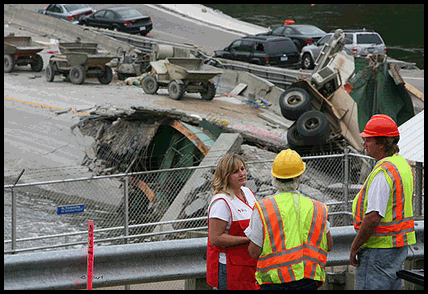Martin H. Krieger compares the lack of oversight involved in today's financial crisis with the transparency and responsibility involved in making bridges.

The Minnesota bridge collapse of 2007. (photo courtesy of The Red Cross)
It is by now well known that about forty years ago a revolution took place in finance (the "quants") that allowed for a more efficient and inventive system. The basic assumptions were that "events" were independent of each other, so that whatever happened to a security or to a society there was no information available that could be used to predict other events. Events were random. One made models of society and finance that were so simple they could have been invented by mathematicians or physicists of about 1900, and in fact they were. Institutions had simple relationships with each other. And third, it was proved again and again, that market processes were efficient and effective (except when there was too much turbulence, and then all bets were off).
Well, the revolution has come a cropper, and it is important that we know why. The best answers are those understood by engineers for why technological devices fail, why bridges fall down, why systems become unstable and crack and fail. The image of Galloping Gertie, the Tacoma Narrows Bridge, twisting in the wind is iconic. Resonances among the bridges elements made for large coherent movements: assumptions of randomness and independence had broken down. For other bridges or electrical systems, a particular part fails catastrophically and the failure or crack then propagates through the system rather than remaining local and confined. There are complex interconnections among the system's parts and so there are collective vulnerabilities that are larger than any single one. And it is proven again and again that you have to look at nonlinear and complex processes, where the engineer is most talented, rather than the nice simple ones of the physicist.
So it turns out that the financial system has many correlated and connected parts, not at all so random in their relationship to each other. Weaknesses are built in, for some parts have never been stress tested, and their cracks propagate leading to major breakdowns. And because these systems often go far from equilibrium, our equilibrium and linear understanding provides us with little guidance in understanding them.
Moreover, corresponding to the contractor who uses poor practices in pouring concrete, and who hides that information from everyone, we have lots of opacity in the financial system so that information turns out to be poor and there is a temptation to misrepresentation.
Finally, corresponding to the engineer who promises a perpetual motion machine, here we have finance professionals creating instruments where risk and rate of return seem to be unconnected-you can get something (better return) with no risk premium.
In the universities there are groups that do "financial engineering." They design these various instruments, instruments that are in fact bridges waiting to sway in the wind, crack, and catastrophically fail-for they encourage corruption, they have almost no actual institutions built into their design, and they often promise something from nothing or are Ponzi schemes. No engineering discipline would survive such corruption of good practices. These instruments were designed for well defined laboratories, not for actual use by real people.
As far as I can tell, there is nothing like financial engineering. There is lots of theory, and lots of wonderful mathematics, and even lots of dealmaking. But the financial engineers are not real engineers who take responsibility for the bridges that fall down. They have no notion of a safety factor.
Martin H. Krieger is a professor at the University of Southern California.

Analysis: Cybertruck Fatality Rate Far Exceeds That of Ford Pinto
The Tesla Cybertruck was recalled seven times last year.

National Parks Layoffs Will Cause Communities to Lose Billions
Thousands of essential park workers were laid off this week, just before the busy spring break season.

Retro-silient?: America’s First “Eco-burb,” The Woodlands Turns 50
A master-planned community north of Houston offers lessons on green infrastructure and resilient design, but falls short of its founder’s lofty affordability and walkability goals.

Test News Post 1
This is a summary

Analysis: Cybertruck Fatality Rate Far Exceeds That of Ford Pinto
The Tesla Cybertruck was recalled seven times last year.

Test News Headline 46
Test for the image on the front page.
Urban Design for Planners 1: Software Tools
This six-course series explores essential urban design concepts using open source software and equips planners with the tools they need to participate fully in the urban design process.
Planning for Universal Design
Learn the tools for implementing Universal Design in planning regulations.
EMC Planning Group, Inc.
Planetizen
Planetizen
Mpact (formerly Rail~Volution)
Great Falls Development Authority, Inc.
HUDs Office of Policy Development and Research
NYU Wagner Graduate School of Public Service

























